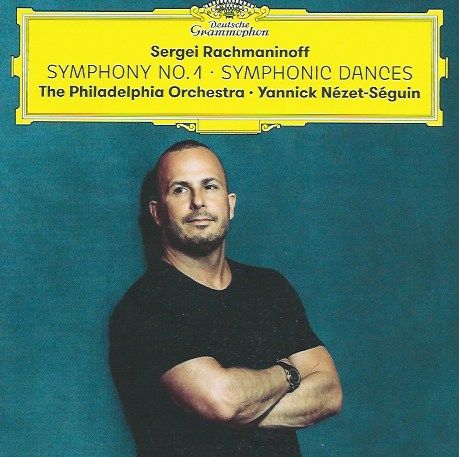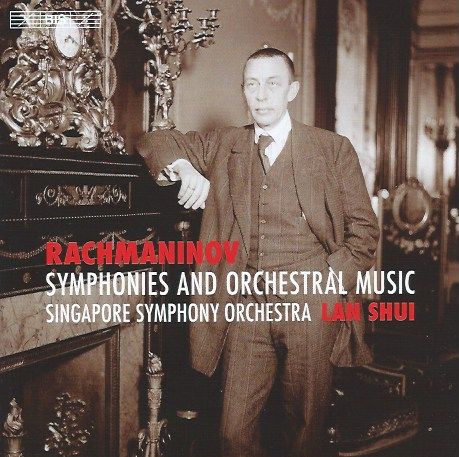Rachmaninov Symphony No. 1: two new rivals
You wait for ages, then two turn up at once ...


You wait for ages, then two turn up at once ...
So today we are looking at two versions of Rachmaninov's First Symphony: one on BIS, with the Singapore Symphony Orchestra under Lan Shui, and the other on Deutsche Grammophon, with The Philadelphia Orchestra under Yannick Nézet-Séguin. We should perhaps note that the BIS presents performances previously issued and collates all of Lan Shui's Rachmaninov in one place (the First Symphony was recorded in 2012); the Nézet-Séguin is a live performance from June 2019 at the Kimmel Center for Performing Arts, Verizon Hall, Philadelphia.
Rachmaninov's First Symphony didn't have the greatest start in life. Any composer's first symphony is a major event for them; so imagine Rachmaninov's reaction when the premiere in March 1897 presented a barely recognisable shadow of the work!. Conducted by an allegedly the worse for wear through alcohol Glazunov, it created huge trauma in the young composer (not helped by a trashing crit by fellow composer César Cui) ; and the result was a crisis of confidence and a hiatus in composition (the next major work came four years later, the Second Piano Concerto).
There was yet another complication: when Rachmaninov emigrated in 1918, he left the score behind, in Russia. The orchestral parts were only rediscovered in 1944, and the score was reconstituted from those, allowing us to experience the work afresh. And how wrong that first impression must have been; the symphony is a wonderful piece!
It is pointless speculation, perhaps, to ponder on how different things could have been if that performance had been better prepared. No worries about preparation here from either account: the Singapore Symphony Orchestra versus The Philadelphia Orchestra may seem an unfair match on first glance, a featherweight against a heavyweight, but it is just surprises like this that buoys a record collector's spirits.
In fact, here we have two performances, both excellent in their own ways. The BIS is part of a boxed set of all the symphonies and is heard on the first disc (logically enough) coupled with the Symphonic Movement in G minor (1891), the so-called "Youth Symphony," and the quarter-hour tone poem Prince Rostislav (also from 1891). The DG couples the First Symphony with the late Symphonic Dances.
Here's the Nézet-Séguin first movement:
This is a superb, alternative view, flexible, bending with Rachmaninov's lines with one of the World's premier orchestras. If, like partridges, one could refer to a pair of Rachmaninov's First Symphony as a "brace," it would surely only be fitting; the first movements of Shui and Nézet-Séguin are both bracing, but particularly the latter. Shui's emphasis is on process; as a wizened old academic this appeals to me; it enables the structure of the movement to come through really clearly. True, the Philadelphia is the finer orchestra (especially in the woodwind section), but the advantage of Shui's taut and controlled approach is that when themes blossom out (try around the five-minute mark) it really makes its effect:
The second movement is a scherzo that once again begins with the "turn" gesture that opened the first movement, if not in quite so overtly dramatic a fashion. The Singapore orchestra is on its toes, textures often gossamer thin:
Over the course of the two movements, it becomes clear that these are two very different recording qualities, the atmospheric, balanced, warm BIS in the Esplanade Concert Hall, Singapore (Producer Ingo Petry, Engineer Hans Kipfer) against the brighter, live performance from Verizon Hall, Philadelphia in June 2019 by Producer Sid McLaughlan and Engineer Andrew Mellor. Both sounds echo the issuing companies' ethos perfectly. The DG is undeniably exciting, and here perhaps Nézet-Séguin pips the Singaporeans to the post:
When it comes to the third movement, that opening gesture is recontextualised again, this time as a sigh. As in the parallel movement of the Second Symphony, the woodwind, particularly the clarinet, have a large part to play in the music. Here's Shui:
... and here's Nèzer-Séguin. The detail in this Philadelphia performance is remarkable, as is the fragility of some of the thin textures, while the moments when the music seems to ominously cloud over are hugely effective.. This time, it's the Philadephians who get my vote:
The finale is a March, and listening to the re-invention of that opening turn shows just how skilfully Rachmaninov can recontextualise a gesture; now, it is resolute, initiating a sequence of events that, despite a pool of rest, culminate in a frenzied close, full of Dies Irae references and a gong stroke that stops the music in its tracks before a hyper-Romantic softening (those Philadelphia strings!) carries us forwards towards the powerful end, where that "turn" gesture returns, itself propelling us into the final stroke :
Shui feels more overtly festive at he opening; it feels as if this is "Rachmaninov's Festive Overture" before the lower strings issue a necessary corrective. Shui's attention to rhythmic detail pays off, too; in the case of the finale, I wouldn't want to be without either.
The Philadelphia performance is filled out by a superb, gripping performance of Rachmaninov's late Symphonic Dances, a piece that actually quotes the First Symphony (when we do a post specifically on this, I'm sure we'll return to this performance for more specifics - for today, the focus is on the First Symphony). That piece was dedicated to the Philadelphia Orchestra and its then conductor, Eugene Ormandy and premiered by them on January 3, 1941, which places Yannick Nèzet-Séguin's performance in direct lineage.
On the BIS boxed set, the Symphony is twinned with an early Symphonic Movement in D minor (the Tchaikovsky symphony movement Tchaikovsky didn't write; really well constructed and in a convincing performance) and the piece Rachmaninov wrote immediately after that, the darkly mysterious Prince Rostislav (after a Tolstoy ballad). Let's hear this latter, if only because of its haunting, dark, even sinister writing, a precursor perhaps to the miracles Rachmaninov was to achieve later in The Isle of the Dead:
